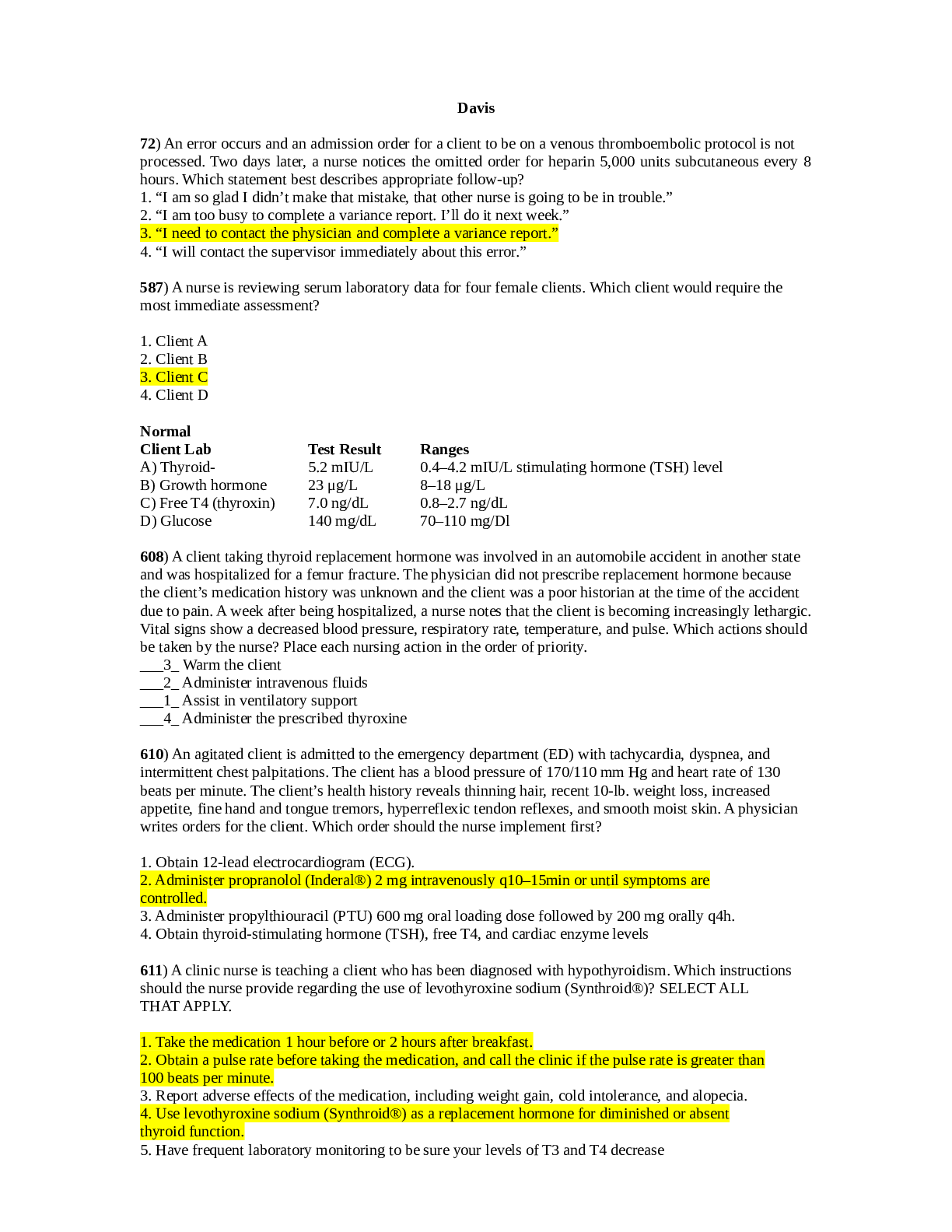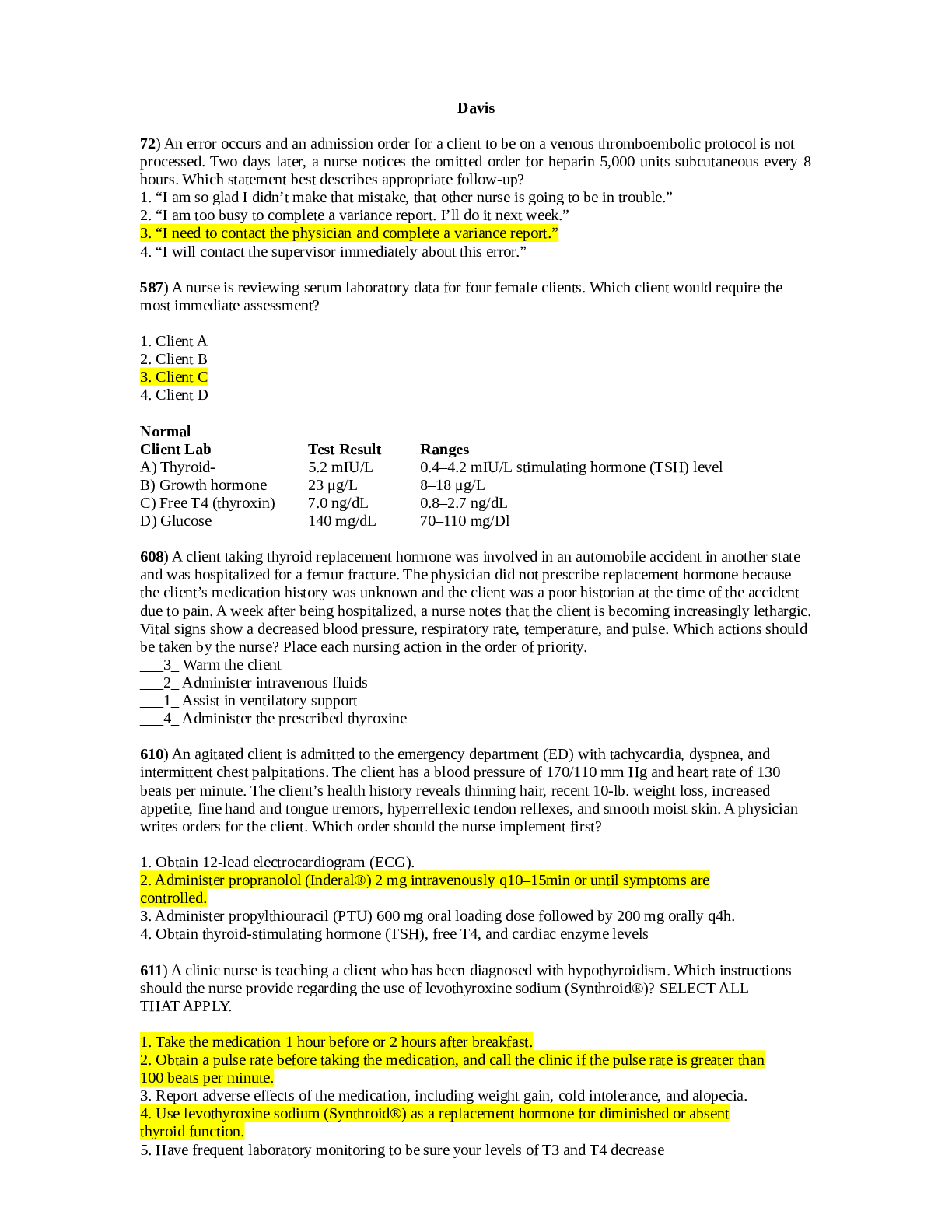72) An error occurs and an admission order for a client to be on a venous thromboembolic protocol is not
processed. Two days later, a nurse notices the omitted order for heparin 5,000 units subcutaneous every 8
hours. Which statement best describes appropriate follow-up?
1. “I am so glad I didn’t make that mistake, that other nurse is going to be in trouble.”
2. “I am too busy to complete a variance report. I’ll do it next week.”
3. “I need to contact the physician and complete a variance report.”
4. “I will contact the supervisor immediately about this error.”
587) A nurse is reviewing serum laboratory data for four female clients. Which client would require the
most immediate assessment?
1. Client A
2. Client B
3. Client C
4. Client D
Normal
Client Lab
A) Thyroid-
B) Growth hormone
C) Free T4 (thyroxin)
D) Glucose
Test Result
5.2 mIU/L
23 μg/L
7.0 ng/dL
140 mg/dL
Ranges
0.4–4.2 mIU/L stimulating hormone (TSH) level
8–18 μg/L
0.8–2.7 ng/dL
70–110 mg/Dl
608) A client taking thyroid replacement hormone was involved in an automobile accident in another state
and was hospitalized for a femur fracture. The physician did not prescribe replacement hormone because
the client’s medication history was unknown and the client was a poor historian at the time of the accident
due to pain. A week after being hospitalized, a nurse notes that the client is becoming increasingly lethargic.
Vital signs show a decreased blood pressure, respiratory rate, temperature, and pulse. Which actions should
be taken by the nurse? Place each nursing action in the order of priority.
___3_ Warm the client
___2_ Administer intravenous fluids
___1_ Assist in ventilatory support
___4_ Administer the prescribed thyroxine
610) An agitated client is admitted to the emergency department (ED) with tachycardia, dyspnea, and
intermittent chest palpitations. The client has a blood pressure of 170/110 mm Hg and heart rate of 130
beats per minute. The client’s health history reveals thinning hair, recent 10-lb. weight loss, increased
appetite, fine hand and tongue tremors, hyperreflexic tendon reflexes, and smooth moist skin. A physician
writes orders for the client. Which order should the nurse implement first?
1. Obtain 12-lead electrocardiogram (ECG).
2. Administer propranolol (Inderal®) 2 mg intravenously q10–15min or until symptoms are
controlled.
3. Administer propylthiouracil (PTU) 600 mg oral loading dose followed by 200 mg orally q4h.
4. Obtain thyroid-stimulating hormone (TSH), free T4, and cardiac enzyme levels
611) A clinic nurse is teaching a client who has been diagnosed with hypothyroidism. Which instructions
should the nurse provide regarding the use of levothyroxine sodium (Synthroid®)? SELECT ALL
THAT APPLY.
1. Take the medication 1 hour before or 2 hours after breakfast.
2. Obtain a pulse rate before taking the medication, and call the clinic if the pulse rate is greater than
100 beats per minute.
3. Report adverse effects of the medication, including weight gain, cold intolerance, and alopecia.
4. Use levothyroxine sodium (Synthroid®) as a replacement hormone for diminished or absent
thyroid function.
5. Have frequent laboratory monitoring to be sure your levels of T3 and T4 decrease
Read More


